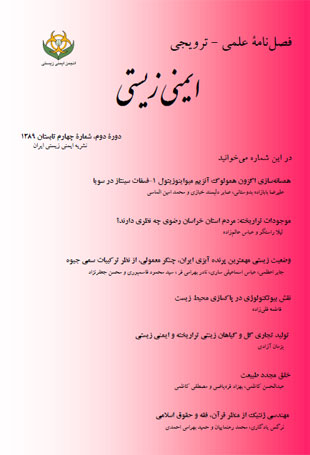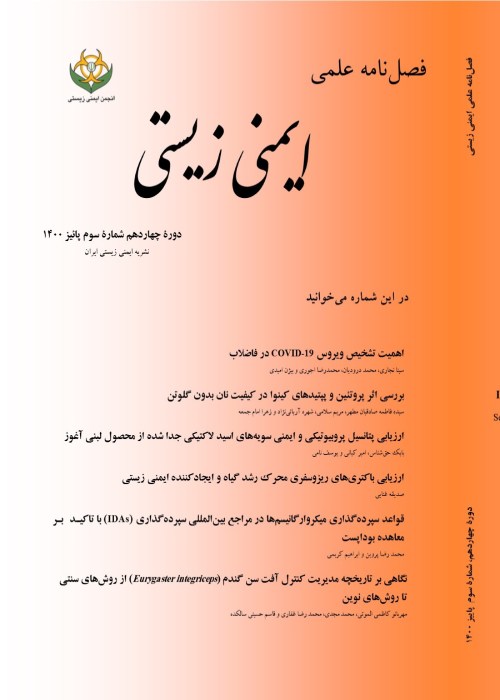فهرست مطالب

فصلنامه ایمنی زیستی
سال دوم شماره 4 (تابستان 1389)
- تاریخ انتشار: 1389/04/20
- تعداد عناوین: 8
-
-
صفحه 67
-
معرفی کتابصفحه 87
-
Page 9Sequence data from genomics projects on soybean has recently been made available and can be used for cloning genes or other genetic elements. In this study a pair of primer was designed based on the exon 3 of a maize gene coding for myo-inositol-1-phosphate synthase. This primer pair was used to amplify the homologous DNA from soybean. This fragment was cloned in a T/A vector and sequenced. There was a complete similarity between the sequence of the exon 3 of the maize gene and the genes coding for myo-inositol-1-phosphate synthase and chlorophylase enzyme in soybean. Considering the biological importance of this exon, this can now be used for knock out or overexpression of this gene in soybean.Keywords: Chlorophylase, Myo, inositol, 1, phosphate synthase, Local homology
-
Page 15The purpose of this article is to assess public views, knowledge and influencing factors on the consumer acceptance of GMO crops in Khorasan Razavi Province. In order to assess a more diverse cultural and geographical spectrum, a questionnaire survey with 39 items was conducted on 320 people from 3 cities in Khorasan Razavi Province (Mashhad, Nyshabor and Sabzevar) in fall 2008. We examined the consumer acceptance of biotechnology by modeling their views about the potential of biotechnology to improve the quality of life. The results indicated that participants had a complex mental picture of plant biotechnology, including environmental consequences, socio-economic and value-driven issues. Data analysis indicated that in general, public knowledge level about this technology was low. But, public attitude towards this technology was positive and the majority of participants agreed with the production and consumption of these products in Iran. Also young, male and educated people showed more tendency to consume GMO crops compared to other groups of people. Over all, the results of this survey indicated that there is a direct relationship between public knowledge level and the acceptance of this technology. Consequently, the progress of this technology in Khorasan Razavi Province needs to prepare a suitable ground for improving public knowledge level in this content in order to make a rational judgment about the risks and benefits of this technology.Keywords: Biosafety, Biotechnology, Consumers acceptance, Khorasan Razavi, Genetically Modified Organisms (GMO)
-
Page 29Mercury is one of the heavy metals that dose not have any useful role in body. Biological accumulation, abundance, wide geographical distribution and high toxicity of mercury make it the most significant pollutant among other heavy metal pollutants. Birds are the best animals to determine the quality of the environment; biological conditions for human and the extent of contamination. The purpose of present study was to determine the total mercury level in feather, liver, kidney and muscle in Coot (Fulica atra). Coot is an aquatic bird that is being hunted in Iran as a favorite food. To achieve these purposes, two wetlands Anzali and Gomaishan in the south coastal of the Caspian Sea, Iran, were chosen. Mercury concentrations were determined by the LECO AMA 254 Advanced Mercury Analyzer and were 0.23, 0.09, 0.08 and 0.01 mg/kg, respectively. There were significant difference among all tissues except in liver and kidney (P < 0.05) of birds hunted in these two locations. Our result showed mercury concentration in this bird were lower than the determined permitted level by WHO. Accumulated levels of mercury in tissues especially liver and kidney of this bird may be used to determine the level of mercury contamination.Keywords: Mercury, Coot, Caspian Sea, Bioindicator
-
Page 45The measures of reaching to sustainable development is one of the most attractive aspects of modern to biotechnology. Biotechnology has tremendous potentials for food production. moreover it reduces the application of chemical substances in agriculture, as well as, the expense of substances. Biotechnology can also reduce the negative effects of traditional agriculture on the environment by reduced farm practices such as tillaging. Nowadays, biogas has been used in many parts of the world for attaining self-sufficiency and sustainable development. Biogas is a low cost source and is an alternative to solve waste material. The aim of this study is to review and recognize the significant role of biotechnology for environmental conservation and bioremediation.Keywords: Biotechnology, Biogas, Biofilteration, Environment
-
Page 51Increasing economic importance of ornamental plants worldwide makes it necessary to use new methods to improve different characters. With novelty being a major factor for the ornamental industry, attempts to use biotechnology for the manipulation of ornamental plant characters started soon after the first plants could be transformed. One of the major obstacles for commercialization of transgenic crops is Biosafety regulations n particular when the product is intended for human consumption as food. In contrast to transgenic food crops transgenic ornamentals do not have to be tested for food safety. This advantage will facilitate commercialization of new cultivars introduced by genetic engineering methods. There are many characters in ornamental plants that have been altered using biotechnological methods, including flower color, postharvest quality, pest and disease resistance, flowering time, flower structure, abiotic stress tolerance and floral scent. Despite these achievements, up to now Moon series of Carnation and APPLAUSETM Rose are the only examples for commercialized genetically engineered ornamentals.Keywords: Biosafty, Commercialization, Ornamental plants, Genetic engineering
-
Page 67This article offers an integrative, interdisciplinary model of bereavement as a biotechnology developmental process that unfolds in cultural context of mankind about dignity of nature due to creating unusual bio-molecules or microorganisms. The investigation of chemical, biochemical, biological and even social evolution of elements, molecules and life forms existing in our solar system and the Earth has, in the past, included observations, theoretical modeling, and laboratory simulations of these subjects. However, one of the principal successes of novel technologies and particularly biotechnology (molecular biology, genetic engineering, systems biology, gene therapy etc) has been the creation of microorganisms, small or complexes bio-molecules that can serve as simplified models or even more complicated bio-molecules complexes commonly not found in nature. Creation of different microorganisms or bio-molecules, by human and newly developed biosciences, has raised concerns about unusual natural functions. The current challenge and how to comply these activities with religious concerns and the dignity of the nature (aspects from ethical, social, ecological and biosafety issues) about these subjects are to expand the palette of these functional subjects is how to integrate them in recreating a new kind of "nature' that can be called as "second nature' or "repeated nature".Keywords: Biosafety, Genome manipulation, Dignity, Second nature
-
Page 81This paper attempts to extract the view of Holly Quran and Islamic Law about new technologies with emphasis on modern biotechnology (Genetic Engineering). We conclude that Almighty God has preserved the integrity of his religion for all ages. Islam is an open religion and endorses scientific achievements and encourages research and development with the intention to improve human welfare. In fact scientific innovations including plant and animal improvement using scientific tools are not only "permitted" in Islam, but are sometimes considered as "obligatory task" where neglecting the use of these innovations will result in poverty, hunger and other human sufferings. In Islam reasonable changes to nature is also allowed as has been practiced by almost all messengers who where farmers.Keywords: Genetic engineering, Holly Quran, Islamic view, Religion


